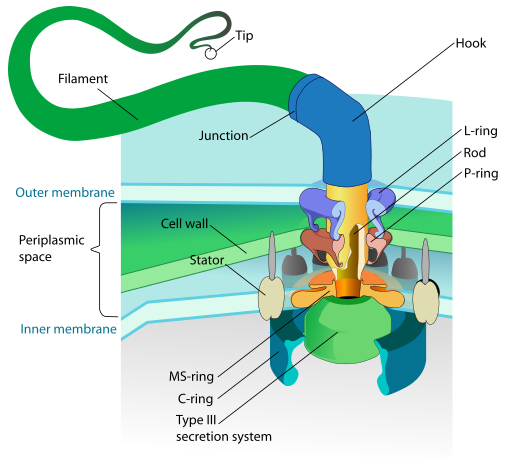Chapter 5 Further Applications of Newton’s Laws: Friction, Drag
Flagellum
As Wikipedia[1] explains flagellum (/fləˈdʒɛləm/; plural: flagella) is a lash-like appendage that protrudes from the cell body of certain bacteria and eukaryotic cells termed as flagellates. A flagellate can have one or several flagella. The primary function of a flagellum is that of locomotion, but it also often functions as a sensory organelle, being sensitive to chemicals and temperatures outside the cell.[1][2][3][4] The similar structure in the archaea functions in the same way but is structurally different and has been termed the archaellum.[5]
Flagella are organelles defined by function rather than structure. Flagella vary greatly. Both prokaryotic and eukaryotic flagella can be used for swimming but they differ greatly in protein composition, structure, and mechanism of propulsion. The word flagellum in Latin means whip.
The motors are powered by ATP. We will talk more about this important molecule in the energy chapter. https://en.wikipedia.org/wiki/Adenosine_triphosphate
An example of a eukaryotic flagellate cell is the mammalian sperm cell, which uses its flagellum to propel itself through the female reproductive tract.[7] Here is a video from the University of Washington, Washington State, USA. It shows mouse sperm. It will open automicallyh below if you are reading this book online. https://www.youtube.com/watch?v=1wRAHHrttYs
Video of mouse sperm swimming
E. coli bacterium have several flagella. A scholarly article about this motion can be found in the National Centre for Biology. Here is a video of E. Coli swimming from the RaoLab. You can find it here: https://www.youtube.com/watch?v=ZV5CfOkV6ek&feature=youtu.be . If you are reading this book online it will open automatically. This is E. coli chemotaxis visualized using fluorescent labeling. Chemotaxis is the directional movement of an organism or a living motile cell in response to certain diffusible chemicals in the environment.
Let us calculate the drag force on an E. Coli. Flagella can rotate at tens of revolutions per second (like a car engine) and act like propellers to provide thrust to the cell. The bacterium E. coli is propelled by several flagella and can swim at 20 microns/second = 2 x 10-5 m/s.
We can calculate the drag force on an idealized spherical bacterium swimming in water. For ease of calculation, we assume:
- the bacterium is a sphere of radius R = 1 micron = 1.0 x 10 -6 m
- the fluid medium is water with a viscosity η = 1.0 x 10-3 kg / m•s
- the density of the cell is that of water ρ = 1.0 x 103 kg/m3
- the speed of the bacterium is v = 2.0 x 10-5 m/s
We need to find the mass of the cell,
density = mass / volume so mass = (density) ( volume of sphere) = (density) ( 4/3 π R3)
mass = (1.0 x 103 kg/m3) (4/3 π (1.0 x 10-6 m) 3) = 4.2 x 10 -15 kg
We need to find the drag force coefficient c1 = 6 π η R
c1 = 6 π (1.0 x 10-3 kg/m • s) (1.0 x 10-6 m ) = 1.9 x 10-8 kg/s
We need to then find the drag force = F drag = c1 v
F drag = ( 1.9 x 10-8 kg/s ) (2.0 x 10-5 m/s ) = 3.8 x 10 – 13 kg m/s2
F drag = 3.8 x 10– 13 N = 0.38 pN Remember 1 p = 1 pico = 1 x 10 -12
If the E. Coli stopped swimming then the deceleration would be all due to the drag force and it would have a magnitude of: acceleration = ( F drag ) / mass
a = ( 3.8 x 10– 13 N ) / ( 4.2 x 10 -15 kg ) = 90 m/s2
The drag force depends on the speed of the motion, but if you make an incorrect assumption to get a “back of the envelope” stopping distance and assume a constant deceleration, the distance could be found using the kinematic equations
v final 2 = v initial 2 + ( 2 acceleration displacement)
Remember that the acceleration would be negative as the E. Coli slows down and the final velocity is zero as you are looking for the stopping distance.
0 = v initial 2 + ( 2 acceleration displacement)
stopping distance = displacement = (v initial 2 ) / ( 2 a )
stopping distance = ( 2.0 x 10-5 m/s ) 2 / ( 2 ) ( 90 m/s2 )
stopping distance = 2.2 x 10 -12 m
Remember that one atom is about 1 x10 -10 m or one angstrom.
This is a very short stopping distance.
If you use calculus to take into account the decreasing drag force as the E. Coli slows down you get a stopping distance of about 4 x 10 -12 m
Flagellum motors
How does this actually work inside the cell? Here is a helpful public domain image.


